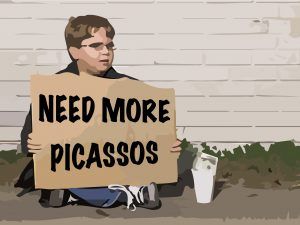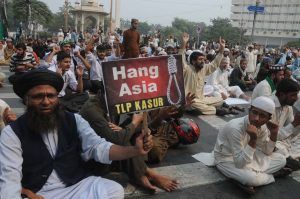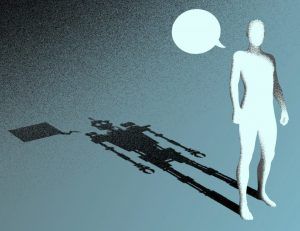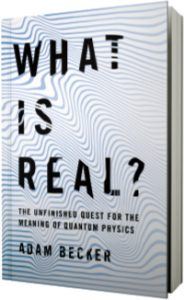by Jalees Rehman

The World Health Organization (WHO) estimates that over a billion people live with some form of disability, expressed as impairments, activity limitations and participation restrictions. Disabilities are often manifestations of health conditions and as such, people suffering from disabilities not only require general medical care such as immunizations and preventive screenings but also need additional care to address the underlying health conditions. According to the WHO, people with disabilities are far more likely to suffer catastrophic health expenditures and receive inadequate medical care than people without disabilities. In addition to the medical and financial challenges, people with disabilities are often isolated and marginalized in society. The lack of political participation by people with disabilities in politics is especially concerning because it sets in motion a vicious cycle of marginalization. If the voices of people with disabilities are not adequately represented in the political arena, then it becomes less likely that governmental measures are taken to ensure adequate medical care and social integration of people with disabilities.
The researchers Lisa Schur and Meera Adya recently studied the political participation of people with disabilities in the United States in their article Sidelined or Mainstreamed? Political Participation and Attitudes of People with Disabilities in the United States. They used data from four US surveys: the 2008 and 2010 Current Population Surveys (CPS), the 2006 General Social Survey (GSS), and the 2007 Maxwell Poll on Citizenship and Inequality. The surveys ask respondents whether they suffer from distinct forms of impairment such as visual, hearing, mental-cognitive or mobility. There were 12,027 people in the 2008 CPS and 12,064 people in the 2010 who answered yes to at least one of the disability questions. The large sample size of CPS and the inclusion of a “voting supplement” in the CPS during even-numbered years allowed the researchers to study the extent of political participation by people with disabilities. Read more »

 This year – 2018 – marks something truly auspicious. This is the semi-centennial of the invention of the Zombie. In these fifty years, let’s face it, we have been completely overrun. Zombies are everywhere. They are in our movies, tv shows, books, and comic books, plus, out here in the real world where the Center for Disease Control has a comprehensive Zombie preparedness and education plan and there are Zombie-walks, Zombie-conventions, and, anyway, didn’t you see them this Halloween? The most popular Zombie tv show, “The Walking Dead”, has been streaming for almost ten years – and the comic book it is based on is still going strong. At least one Pulitzer Prize and National Book Award winning author has written a straight-up zombie novel – Colson Whitehead’s “Zone One”. So, what’s with all the Zombies?
This year – 2018 – marks something truly auspicious. This is the semi-centennial of the invention of the Zombie. In these fifty years, let’s face it, we have been completely overrun. Zombies are everywhere. They are in our movies, tv shows, books, and comic books, plus, out here in the real world where the Center for Disease Control has a comprehensive Zombie preparedness and education plan and there are Zombie-walks, Zombie-conventions, and, anyway, didn’t you see them this Halloween? The most popular Zombie tv show, “The Walking Dead”, has been streaming for almost ten years – and the comic book it is based on is still going strong. At least one Pulitzer Prize and National Book Award winning author has written a straight-up zombie novel – Colson Whitehead’s “Zone One”. So, what’s with all the Zombies?
 “They all go the same way. Look up, then down and to the left,” the EMT said. “Always.”
“They all go the same way. Look up, then down and to the left,” the EMT said. “Always.”
 In Tian Shan mountains of the legendary snow leopard, errant wisps of mist float with the speed of scurrying ghosts, there is a climbers’ cemetery, Himalayan Griffin vultures and golden eagles are often sighted, though my attention is completely arrested by a Blue whistling thrush alighting on a rock— its plumage, its slender, seemingly weightless frame, and its long drawn, ventriloquist song remind me of the fairies of Alif Laila that were turned to birds by demons inhabiting barren mountains.
In Tian Shan mountains of the legendary snow leopard, errant wisps of mist float with the speed of scurrying ghosts, there is a climbers’ cemetery, Himalayan Griffin vultures and golden eagles are often sighted, though my attention is completely arrested by a Blue whistling thrush alighting on a rock— its plumage, its slender, seemingly weightless frame, and its long drawn, ventriloquist song remind me of the fairies of Alif Laila that were turned to birds by demons inhabiting barren mountains.
 On a recent windy morning, walking past the Soldiers’ and Sailors’ Monument on West 89th Street in New York City, seeing the flag at half mast, just days before the
On a recent windy morning, walking past the Soldiers’ and Sailors’ Monument on West 89th Street in New York City, seeing the flag at half mast, just days before the  Ronald Reagan was elected President in 1980 with an attitude and agenda similar to Trump’s—to restore America to its rightful place where “someone can always get rich.” His administration arrived in Washington firm in its resolve to uproot the democratic style of feeling and thought that underwrote FDR’s New Deal. What was billed as the Reagan Revolution and the dawn of a New Morning in America recruited various parties of the dissatisfied right (conservative, neoconservative, libertarian, reactionary and evangelical) under one flag of abiding and transcendent truth—money ennobles rich people, making them healthy, wealthy and wise; money corrupts poor people, making them ignorant, lazy and sick.
Ronald Reagan was elected President in 1980 with an attitude and agenda similar to Trump’s—to restore America to its rightful place where “someone can always get rich.” His administration arrived in Washington firm in its resolve to uproot the democratic style of feeling and thought that underwrote FDR’s New Deal. What was billed as the Reagan Revolution and the dawn of a New Morning in America recruited various parties of the dissatisfied right (conservative, neoconservative, libertarian, reactionary and evangelical) under one flag of abiding and transcendent truth—money ennobles rich people, making them healthy, wealthy and wise; money corrupts poor people, making them ignorant, lazy and sick. When my grandfather died last fall, it fell to my sisters and me to sort through the books and papers in his home in East Tennessee. My grandfather was a nuclear physicist, my grandmother a mathematician, and among their novels and magazines were reams of scientific publications. In the wood-paneled study, we passed around great sheaves of papers for sorting, filling the air with dust.
When my grandfather died last fall, it fell to my sisters and me to sort through the books and papers in his home in East Tennessee. My grandfather was a nuclear physicist, my grandmother a mathematician, and among their novels and magazines were reams of scientific publications. In the wood-paneled study, we passed around great sheaves of papers for sorting, filling the air with dust. After spending eight years on death row, Asia Bibi, a Christian, was acquitted by Pakistan’s Supreme Court this week. For many here it seemed like a good day. The country’s highest court had finally delivered justice and released a woman whose life has already been destroyed by years in solitary confinement. The court decision quoted Islamic scriptures, bits of letters by the Prophet Muhammad and a smattering of Shakespeare. A great wrong was righted.
After spending eight years on death row, Asia Bibi, a Christian, was acquitted by Pakistan’s Supreme Court this week. For many here it seemed like a good day. The country’s highest court had finally delivered justice and released a woman whose life has already been destroyed by years in solitary confinement. The court decision quoted Islamic scriptures, bits of letters by the Prophet Muhammad and a smattering of Shakespeare. A great wrong was righted. Donald Trump’s election in 2016 as president of the United States can be taken as a striking example of the rise of right-wing populism around the world.
Donald Trump’s election in 2016 as president of the United States can be taken as a striking example of the rise of right-wing populism around the world. LAST WEEK, AS
LAST WEEK, AS  The word Victorian tends to evoke old-fashioned ideas: women confined in corsets, strict gender roles, and a prudishness about all things sexual. In a world where conspicuous consumerism and self-expression rule, these nineteenth-century notions of self-restraint and self-denial seem hopelessly outdated.
The word Victorian tends to evoke old-fashioned ideas: women confined in corsets, strict gender roles, and a prudishness about all things sexual. In a world where conspicuous consumerism and self-expression rule, these nineteenth-century notions of self-restraint and self-denial seem hopelessly outdated. When Ammar Campa-Najjar was nine years old, his Palestinian father moved his family to Gaza, the narrow strip of Palestinian territory that has been under an Israeli blockade for over a decade. His family was living there when the second intifada broke out in 2000, and Israeli security forces crushed a violent Palestinian uprising with deadly and often indiscriminate force. He remembers when the electricity and water supply were cut off and sheltering in his kitchen while his neighbourhood was bombed. He remembers how a military Hummer crashed into his family’s car, causing him to burn his back and fracture his thigh and putting his younger brother into a coma.
When Ammar Campa-Najjar was nine years old, his Palestinian father moved his family to Gaza, the narrow strip of Palestinian territory that has been under an Israeli blockade for over a decade. His family was living there when the second intifada broke out in 2000, and Israeli security forces crushed a violent Palestinian uprising with deadly and often indiscriminate force. He remembers when the electricity and water supply were cut off and sheltering in his kitchen while his neighbourhood was bombed. He remembers how a military Hummer crashed into his family’s car, causing him to burn his back and fracture his thigh and putting his younger brother into a coma. “Will no one rid me of this meddlesome priest?” asked Henry II as he instigated the murder of the Archbishop of Canterbury, Thomas Becket, in 1170. Down through the ages, presidents and princes around the world have been murderers and accessories to murder, as the great Harvard sociologist Pitirim Sorokin and Walter Lunden documented in statistical detail in their masterwork
“Will no one rid me of this meddlesome priest?” asked Henry II as he instigated the murder of the Archbishop of Canterbury, Thomas Becket, in 1170. Down through the ages, presidents and princes around the world have been murderers and accessories to murder, as the great Harvard sociologist Pitirim Sorokin and Walter Lunden documented in statistical detail in their masterwork  IN THE ANNUS MIRABILIS
IN THE ANNUS MIRABILIS An increasingly visible school of heterodox macroeconomics, Modern Monetary Theory (MMT), makes the case for functional finance—the view that governments should set their fiscal position at whatever level is consistent with price stability and full employment, regardless of current debt or deficits. Functional finance is widely understood, by both supporters and opponents, as a departure from orthodox macroeconomics. We argue that this perception is mistaken: While MMT’s policy proposals are unorthodox, the analysis underlying them is entirely orthodox. A central bank able to control domestic interest rates is a sufficient condition to allow a government to freely pursue countercyclical fiscal policy with no danger of a runaway increase in the debt ratio. The difference between MMT and orthodox policy can be thought of as a different assignment of the two instruments of fiscal position and interest rate to the two targets of price stability and debt stability. As such, the debate between them hinges not on any fundamental difference of analysis, but rather on different practical judgements—in particular what kinds of errors are most likely from policymakers.
An increasingly visible school of heterodox macroeconomics, Modern Monetary Theory (MMT), makes the case for functional finance—the view that governments should set their fiscal position at whatever level is consistent with price stability and full employment, regardless of current debt or deficits. Functional finance is widely understood, by both supporters and opponents, as a departure from orthodox macroeconomics. We argue that this perception is mistaken: While MMT’s policy proposals are unorthodox, the analysis underlying them is entirely orthodox. A central bank able to control domestic interest rates is a sufficient condition to allow a government to freely pursue countercyclical fiscal policy with no danger of a runaway increase in the debt ratio. The difference between MMT and orthodox policy can be thought of as a different assignment of the two instruments of fiscal position and interest rate to the two targets of price stability and debt stability. As such, the debate between them hinges not on any fundamental difference of analysis, but rather on different practical judgements—in particular what kinds of errors are most likely from policymakers.